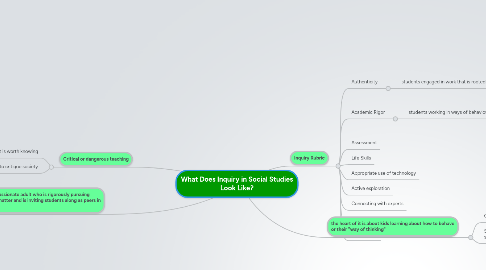What Does Inquiry in Social Studies Look Like?
作者:Cha Castrillo


1. Critical or dangerous teaching
1.1. refers to teaching that engages students in the often-unasked questions about the what and how students learn in schools, connecting schools to broader debates over what is worth knowing
1.2. should be getting kids to critique society
2. Rigour – being in the company of passionate adult who is rigorously pursuing inquiry in the area of their subject matter and is inviting students along as peers in that discourse
3. Inquiry Rubric
3.1. Authenticity
3.1.1. students engaged in work that is rooted in the real world
3.2. Academic Rigor
3.2.1. students working in ways of behaviours that mirror the disciplines outside of school
3.2.1.1. Critical thinking consortium
3.2.1.1.1. - Based on making judgements on evidences
3.2.1.2. Benchmarks of historical thinking
3.2.1.2.1. establish historical significance; use primary source evidence; identify continuity and change; analyze cause and consequence; take historical perspectives; understands ethical dimensions of history;
3.2.1.3. Throughline questions
3.2.1.3.1. ask provocative and relevant questions that encourage teachers and students to make connection between 3 essence
